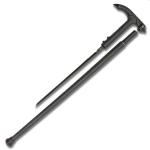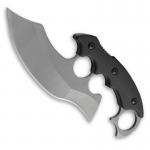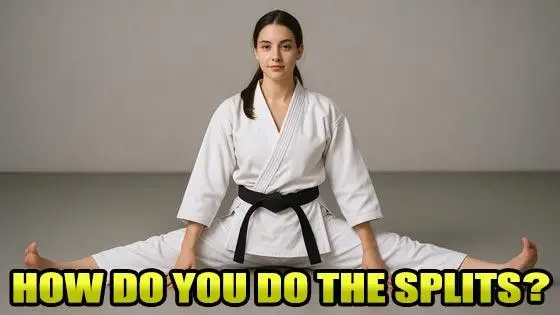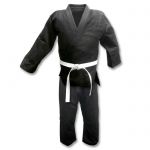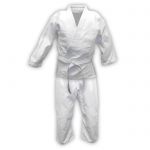Judo Gi - Japanese Judo Uniform with a Kimono & Judo Pants
-
From $59.95
-
From $54.95
The judo gi is unlike other martial arts uniforms in a number of ways. One of the most important features that set it apart is the material. Judo uniforms are made from a heavier, thicker, and more durable cotton fabric compared to the lightweight material of other martial arts gis. This fabric is woven in a specific way to create a rough texture that is capable of enduring the powerful grips, throws, and groundwork that judo is known for. The strength of the fabric is essential for resisting wear and tear during aggressive training sessions. When you are practicing judo, especially during high-intensity sparring or competitions, your gi will be subjected to a lot of pulling, twisting, and tugging. That's why it's critical to purchase a high-quality judo gi that is reinforced and able to handle these forces without tearing.
A typical judo uniform consists of a durable jacket, known as the kimono, and pants. The jacket is made of tightly woven fabric that resists ripping even when it's pulled on forcefully. A lot of judoka (practitioners of judo) prefer a jacket with a thicker weave, such as the canvas or Hemp weave, as these are more durable for high-level competition and training. The pants of a judo gi also play an important role. They are typically made from a reinforced cotton material, with additional reinforcement around the knees to help protect against mat burns when performing ground techniques like pins and sweeps.
The reinforced stitching and high-quality fabric are essential for durability. A judoka gi that is not built well may easily fall apart during intense rolling or while executing complex throws. Judo pants often feature double or even triple stitching along the seams and at key stress points, such as the knees and the waistband. This attention to detail ensures that the uniform will last through countless training sessions, without compromising the comfort or flexibility necessary to perform judo techniques properly.
One of the primary differences between a judo gi and other martial arts uniforms, like a karate gi or jiu-jitsu gi, is the fit and cut of the garment. Judo gis are generally a little looser in fit compared to karate or Brazilian jiu-jitsu gis. This is by design, as judo techniques often involve gripping the opponent's clothing, using it to execute throws, and to apply joint locks. A looser fit allows for easier grip and movement, while still maintaining durability. The sleeves on a judo gi tend to be longer and looser than those on a karate gi, again to accommodate gripping and pulling techniques. Additionally, judo gi pants are typically more spacious and provide more room for movement, particularly in the hip and thigh areas, which are essential when performing complex judo throws.
When it comes to the difference between a judo gi and a jiu-jitsu gi, the contrast lies in the design and intended use of the uniform. Both judo and Brazilian jiu-jitsu practitioners engage in ground fighting and use the gi to aid in submissions and control. However, jiu-jitsu gis are usually made of a slightly lighter material and have a more fitted design, particularly around the sleeves and legs. This is because jiu-jitsu focuses on submissions and holds, with less emphasis on standing techniques like throws. The sleeves of a jiu-jitsu gi are often more fitted to prevent opponents from easily grabbing them, whereas the looser sleeves of a judo gi are designed specifically for grip-based fighting.
The judogi has evolved over time but remains closely linked to the roots of the martial art. Historically, judo uniforms were very similar to the traditional kimono worn in Japan, but as the sport of judo gained popularity worldwide, the uniform was standardized to suit the needs of both practitioners and competitions. Today, a judo gi is often identified by its clean white color, although some may have blue gis, especially for competition. The color of the gi in judo competitions is important because it helps differentiate between the two competitors; one wears a white gi, and the other wears a blue gi. This color distinction aids referees and spectators during fast-paced matches. The judogi is not just a symbol of judo but a functional piece of clothing designed to support the unique needs of judo practitioners.
Judo, as a martial art, emphasizes balance, timing, and technique rather than raw strength. It is a sport where a smaller and weaker individual can overcome a larger opponent by using the principles of leverage and efficient movement. The judo outfit plays a crucial role in helping practitioners develop these skills by providing a uniform that is both durable and functional. This uniform allows judoka to practice throwing techniques, joint locks, and other essential skills in a safe and effective way.
The roots of judo can be traced back to the late 19th century when Jigoro Kano developed the art as a way to promote physical education and mental discipline. Judo uniforms were designed as part of this philosophy, and Kano intended for it to reflect the values of the martial art itself: respect, discipline, and efficiency. While the design of the uniform has been refined over the years, the fundamental principles behind its construction have remained the same.
When purchasing a judo gi, you should look for one that matches your level of expertise, body type, and training intensity. Beginners often opt for a lighter, more affordable gi, while experienced judoka might prefer a higher-end, competition-grade judo uniform made from premium cotton or even hemp. There are also several brands known for producing top-quality judo clothing, so it's important to do some research to ensure you're getting a gi that fits well, holds up over time, and allows for optimal movement during training.
At KarateMart.com, we offer a wide range of judo uniforms to suit all levels of practitioners, from beginners to advanced competitors. Whether you're looking for a durable judo gi for sale or a high-performance judo kimono for competition, we have what you need. Our judo uniforms are designed with comfort, durability, and functionality in mind. If you're searching for the perfect judo gi, our collection includes top-quality brands and various sizes to ensure a perfect fit for every judoka.
What is the Difference Between a Judo Gi and a Jiu Jitsu Uniform?
At first glance, a judo gi and a Brazilian jiu-jitsu (BJJ) gi might look quite similar, especially since both are made of a thick cotton fabric and designed for grappling. However, there are several key differences in both the construction and design of these two uniforms that reflect the distinct techniques, rules, and history of each martial art.
Fabric and Weight
One of the most noticeable differences between a judo gi and a BJJ gi is the fabric weight and texture. Judo gis are generally made from a heavier, thicker, and more durable material. The fabric used in a judo gi typically has a tighter, coarser weave, designed to withstand the rough, aggressive nature of judo techniques; particularly throwing, gripping, and other gripping-heavy movements. The thicker weave also helps the gi endure the intense pulling, tugging, and twisting that is common in judo, where practitioners rely heavily on gripping the opponent's gi to execute throws and controls.
In contrast, BJJ gis are usually lighter and have a smoother texture, though they are still made from durable cotton. The fabric used in BJJ gis tends to have a tighter, less textured weave, allowing for quicker movements and a snugger fit. BJJ practitioners generally prefer this lighter, more flexible fabric to facilitate fluid movements, especially in ground-based techniques such as sweeps, submissions, and escapes. While some BJJ gis are reinforced with extra stitching in high-stress areas, the overall emphasis is on providing a gi that allows for a more form-fitting, streamlined look and feel, in contrast to the looser, baggier style seen in judo.
Cut and Fit
The cut and fit of the two uniforms also differ significantly. A judo gi is intentionally cut looser and baggier compared to a BJJ gi. The sleeves on a judo gi are wider and longer, which facilitates gripping for throwing techniques. A loose-fitting gi allows the practitioner to grab the sleeves and collar more effectively for throws and submissions, making it easier to use the uniform itself as a tool in combat. The pants of a judo gi are also more spacious, giving room for the leg movements required for various throws and ground techniques.
On the other hand, a BJJ gi is designed to fit more snugly around the practitioner's body. BJJ practitioners tend to favor a more fitted look to reduce the amount of material that an opponent can grip onto during grappling exchanges. The sleeves and pants in a BJJ gi are typically shorter and more fitted around the body, making it harder for opponents to get a good grip. This is especially important in Brazilian jiu-jitsu, where the uniform is often used to apply and defend against submissions, and having a gi that fits closely can minimize the leverage an opponent has over the fabric.
Reinforcements and Stitching
Both judo and BJJ gis require strong reinforcements due to the nature of grappling, but the areas that are reinforced can differ. In judo, the main areas of reinforcement are the jacket's seams and the knees of the pants. This is because judo practitioners frequently use grips on the gi to perform throws, and the knees often take a lot of wear during ground work. As a result, the stitching around the knees of judo gi pants is reinforced to prevent them from tearing due to constant contact with the mat.
In Brazilian jiu-jitsu, however, the focus of reinforcement is a little different. BJJ gis are often reinforced around the collar, chest, and sleeve areas, as these are critical points for grips and control. The collar, in particular, is an area of interest, as it is often used to choke an opponent in BJJ. BJJ gi pants also feature reinforced knees, but these pants are typically made from a more flexible material compared to judo pants to allow for quicker transitions, sweeps, and leg work.
Collar Design
The collar is another area where judo and BJJ gis differ. Judo gi collars are typically thicker and stiffer, providing a more rigid structure that can be used effectively for gripping during standing exchanges. Judo practitioners rely on the collar to execute various throws and to control their opponent's posture. The thickness and stiffness of the collar make it particularly effective for these purposes, allowing for better control and leverage.
In contrast, the collar on a BJJ gi is often thinner and more flexible. While still strong, the collar is designed with flexibility in mind, as BJJ is more focused on ground fighting, submissions, and escapes. The collar is still used for chokes and controls, but it doesn't need to be as rigid as the one found in a judo gi. The collar's thinner design makes it easier to use for dynamic submissions and transitions during BJJ rolls.
Colors
Traditionally, both judo and BJJ gis come in white, but there are differences when it comes to competition. In judo, competitors wear either a white or blue gi, with blue typically being used to distinguish between the two athletes during tournaments. This color distinction helps referees and spectators easily differentiate between the two competitors during fast-paced matches.
In BJJ, while white is still the most common gi color, other colors such as blue, black, and even purple have become popular over the years. The International Brazilian Jiu-Jitsu Federation (IBJJF) recognizes these colors in competition, but the main emphasis remains on the fit, durability, and performance of the gi rather than its color. BJJ practitioners often wear gi colors based on personal preference or the tradition of their school or academy.
Use of the Gi in Techniques
Perhaps the most significant difference between a judo gi and a BJJ gi lies in the way the uniform is used during training and competition. In judo, the gi is used primarily for grips and throws. Judoka use the collar, sleeves, and pants to perform a wide variety of throws, sweeps, and grips. Since judo is focused heavily on the standing phase of combat, the gi needs to be durable and allow for a strong grip, which is why the looser fit and thicker material of the judo gi are so essential.
In Brazilian jiu-jitsu, however, the gi plays a central role in the groundwork phase. BJJ practitioners use the gi to secure grips for sweeps, submissions, and joint locks. The gi is also an integral tool for controlling an opponent's posture and preventing escapes. While grips are important in both judo and BJJ, Brazilian jiu-jitsu is much more focused on manipulating those grips to apply submissions and establish control on the ground.
Competition Rules
There are also some rule differences in how the gi is utilized in judo and BJJ competitions. In judo, the emphasis is on throws, pins, and submissions, with the primary goal being to either throw your opponent onto the mat or to pin them for an allotted time. A judo gi's design, with its heavier fabric and looser fit, directly supports these techniques.
In contrast, BJJ competitions place more emphasis on submission holds, sweeps, and positional control. BJJ practitioners are often on the ground for a significant portion of the match, and the gi is used for a variety of grips and controls that allow the practitioner to apply joint locks, strangles, and escapes. BJJ gis are designed to be more lightweight and flexible to accommodate this emphasis on groundwork.
Conclusion
In summary, while a judo gi and a Brazilian jiu-jitsu gi may appear to be similar at first glance, they differ in several important ways due to the distinct needs of each martial art. Judo gis are heavier, looser, and designed for gripping and throwing techniques, whereas BJJ gis are lighter, more form-fitting, and built for ground fighting and submissions. Each gi is specially tailored to enhance the performance of practitioners in their respective sports, ensuring that the uniform is not just a piece of clothing, but a vital tool in the practice of these martial arts.






